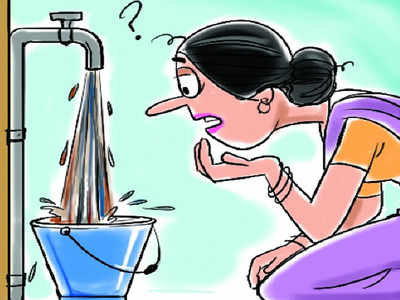Deccan Chronicle 30.05.2013
Hogenakkal water for parched dts

Hogenakkal water supply and fluoride mitigation scheme at the
secretariat after launching the project. —DC
Chennai: It
was a dream come true for thousands of water-starved and
flouride-affected people of Dharmapuri and Krishnagiri districts as
chief minister Jayalalithaa on Wednesday inaugurated the Rs 1,928 crore
Hogenakkal Combined Water Supply Scheme, nearly five decades after it
was conceived. While taking pride for launching the scheme, she blasted
DMK leader Stalin for alleging that the scheme had fallen behind
schedule.
Inaugurating the water project, through
video-conferencing from the secretariat here, the CM said she was
delighted to launch the dream project of the people of Dharmapuri and
Krishnagiri districts. “I feel proud to launch this much-awaited Rs
1,928 crore scheme,” she said.
The
CM also hit out at DMK treasurer Stalin for his ‘malicious’ campign
alleging that the AIADMK had delayed the scheme and he could
complete it in two months if given the chance.
Recalling
that a DPR was prepared for implementing the project when the late MGR
was the chief minister in 1986, she said, “During my first tenure a
project report was prepared for the scheme in 1994, but could not be
implemented owing to lack of funds.”
When
she assumed power for second time, a revised proposal was sent to the
Centre in August 2005, after including few more areas with Rs 1,500
crore financial aid from JICA. “After that, the foundation stone was
laid in 2008 for the project, which triggered protests from the
Karnataka unit of BJP. Against this, I had announced a protest on
August 26, 2008.”
Following
this, a resolution seeking Centre’s assitance to TN was adopted in the
Assembly. But without informing the House, the then CM M.
Karunanidhi announced holding the project till a new government
in Karnataka assumed office after assembly polls. “I tried to raise
the issue in the Assembly but was not permitted. By 2011, when the
AIADMK took over, 50 per cent of the work should have been completed
but only 18 per cent was done”, she said.
Project faced many bumps before fruition
Krishnagiri: The
Hogenakkal drinking water project (HDWP) implemented to provide safe
drinking water to the fluoride-affected Dharmapuri and Krishnagiri
districts crossed several hurdles before its inauguration on Wednesday.
The
locals said the first proposal for the project came in 1960 when K.
Kamaraj was the chief minister. In 1996, the project took shape with
financial assistance from Japan international cooperation agency (JICA).
But this was dropped after international sanctions following the
Pokhran nuclear blast in 1998.
HDWP
was re-started after the countries lifted the sanctions. JICA again
came forward to offer loan for HDWP but the project was opposed by
neighbouring Karnataka, against its approval in May 1997, allowing Tamil
Nadu to use Cauvery for drinking water purpose.
In
March 2008, former Karnataka chief minister B.S. Yeddyurappa was the
first to raise his voice against the project for political reasons and
claimed that the site for the headworks of HDWP, along the course of the
Cauvery in Hogenakkal, belonged to Karnataka.
Yeddyurappa’s
claim sparked controversy and tension in both states. The claim was
later followed by other political and pro-Kannada movements and worsened
the relationship between the two states.
With
works at HDWP held up, Tamil Nadu sought the Union government’s
intervention for smooth implementation of the project. But, Yeddyurappa,
after becoming Karnataka’s CM, gave the green light for HDWP.
The
works for the project were done on a war-footing with 2012 December as
the deadline to complete the project. But, the works were delayed for
other reasons giving room for the opposition to comment that the ruling
AIADMK was shelving HDWP because the foundation stone for the project
was laid in February 2008, during the DMK rule.
On
Wednesday, the police had made elaborate security arrangements across
Dharmapuri and Krishnagiri to prevent group clashes following the poster
war between the AIADMK DMK over the project. The AIADMK members’
posters thanked the chief minister for completing and inaugurating the
project when people in Dharmapuri and Krishnagiri were facing water
shortage.
Time for celebration in two districts
Dharmapuri: Several
thousands of people watched as chief minister J. Jayalalithaa, on
Wednesday, inaugurated the Hogenakkal drinking water project to provide
safe drinking water for the fluoride-affected Krishnagiri and
Dharmapuri districts.
Krishnagiri and Dharmapuri districts
had made elaborate arrangements following the inauguration from Chennai,
using video-conferencing facility.
In
Dharmapuri, the function was held in Ambedkar nagar, with the
participation of collector R. Lily and others. A similar function was
held in Dinnur village of Hosur in Krishnagiri in the presence of
collector T.P. Rajesh and others.
Several lakhs of people
in Dharmapuri and Krishnagiri welcomed the move in their villages by
bursting crackers and distributing sweets immediately after the
inauguration and subsequent release of water from overhead tanks meant
for the project.
Many
villagers also organised special pujas in temples and other places of
worship following the arrival of Cauvery water here. The arrival of the
river water to Dharmapuri and Krishnagiri is significant as the river
was of no use to them before the Hogenakkal drinking water project and
also due to the obstacles faced by the project since 1996.
The
project was implemented at a cost of Rs 1,928.80 crore, received as
loan from Japan international cooperation agency (JICA), to provide safe
drinking water.
TWAD sources
said the Cauvery water is pumped from a height of 1,150 metres from
headworks along the course of the river in Hogenakkal to reach Madam of
Pennagaram.
From Madam, the water is treated and
transported to Dharmapuri and Krishnagiri using pipelines laid to a
distance of 9,965 kilometres for the project.
HDWP
will deliver 128 mld of water for 30 lakh people but the project is
designed with a capacity of 160 mld to meet the requirements of the
expected 45 lakh population in the next 10 years.

